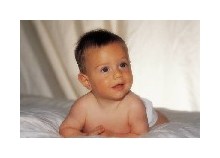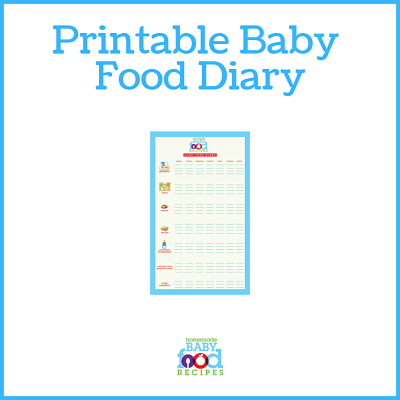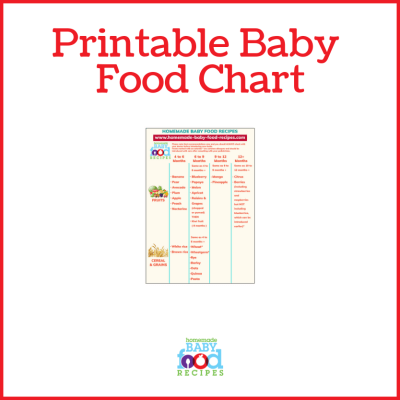An Exciting Milestone Has Arrived –
It’s Time For Baby’s First Foods
Updated: June 16, 2023
Introducing baby’s first foods can be fun!
Prepare yourself with these useful tips – and don’t forget your sense of humour. You’ll need it!
For the first few months, you’ll probably find you end up WEARING more of baby’s first foods than he actually eats!
And a sense of humour is invaluable when dealing with all the well-meant advice you’ll get at this stage.
Everyone seems to know best!
It’s important to find a routine that works for you … and stick to it!
So when should I introduce baby’s first foods?
This is a hugely important question for all new parents, yet is one that will often bring you an overwhelming amount of conflicting answers.
Many medical professionals advise parents to introduce baby’s first foods anywhere from 4 to 6 months.
However, the current recommendation from the World Health Organisation (WHO) and UNICEF is that babies are exclusively breast-fed for the first 6 months.
Solid foods should then be introduced from 6 months, with breastfeeding continuing up to 2 years.
The American Academy of Pediatrics also recommends the introduction of solid foods at 6 months
You may also find that you receive advice from older relatives, advocating the introduction of solid foods far sooner than 6 months – it’s certainly true that babies were given their first foods very early in past generations.
Remember, though, that not as much research had been done into solid feeding at that time… and the information we have now, particularly in regard to food allergies, simply wasn’t available then.
Culturally, there are differences too…
Not only in the ages that babies are first given solid food, but also in the types of food that are given. In Africa, for example, babies are generally introduced to meat before anything else.
Children raised in India, meanwhile, are exposed to spices in their foods from a very early age.
Personally, I love spicy foods and have eaten them whilst pregnant and when breast-feeding.
So, in theory, our children too were enjoying spicy foods before they even started solids!
Hmm… food for thought!
Perhaps the key is to remember that the information given on these pages and elsewhere is meant as a guide.
There are no hard and fast rules and a little flexibility can mean you can tailor make baby’s first foods to his specifications!
Of course, one of the best people to advise you on your baby’s readiness for solids is… your baby!
Review this checklist: baby’s first foods – is baby ready for solids?
If you’ve answered yes to most of these questions, then it might be time for baby’s first foods. But first, there are a few other points to consider.
These days, most experts agree that you shouldn’t be looking at introducing solids until baby is at least 6 months old. And there are good reasons for this…
- Very young babies have poor control of their throat and tongue muscles. This makes swallowing difficult and can cause choking or gagging.
- The tongue thrust reflex is still strong and can make solid feeding difficult.
- The risk of allergies may increase if baby’s first foods are introduced too soon.
Once you are satisfied that your baby is ready, then it’s time to put on your chef’s hat and get cooking baby’s first foods.
Jump straight to…
getting started
First things first – please read through the food preparation and storage guidelines for some important food safety tips.
Don’t forget to label foods as you prepare them for your baby.
Make a note of the preparation date on the label, as this will help you “rotate” stored foods to ensure they are safe for your baby to eat.
It’s a good idea to note the contents, too – pureed foods tend to look alike and it may be important to identify a particular food later on (if your baby experiences an allergic reaction, for example).
Ultimately, you need to ensure that you are providing healthy, balanced nutrition to your baby.
With baby’s first foods, though, you need to keep things simple.
More guides to introducing solids…
Step 1
Pediatricians often recommend starting with a single grain cereal, like baby rice, because it is gluten free and considered easy to digest.
However… there ARE alternatives and many medical professionals are beginning to acknowledge the value of fruits, veggies… or even meat… as suitable first foods.
Read more here – The Best First Food For Baby – Does it HAVE to be Baby Rice?
If you DO choose to introduce rice first, here’s a simple and nutritious recipe to make your own.
Alternatively, you may like to try our baby oatmeal recipes or some barley baby food recipes.
If you have questions about homemade infant cereal, then please check out our FAQ
Step 2
Pick a quiet time of day for baby’s first meal – a time when you won’t be distracted, or feel pressured.
This can be easier said than done – especially if you have other young children at home.
In that case, a “quiet time of day” doesn’t actually exist, so you’ll have to make do with “quieter than usual”!
If your other children are old enough to understand, you could get them to “help” you with this historic first feed – they love being involved.
Step 3
You may like to take the edge off your baby’s appetite by giving him about half his milk feed first or feeding him about an hour or so after breastfeeding.
If he’s too hungry, he’ll probably end up screaming in frustration – and so will you!
Step 4
For very young babies, mix about one tablespoon of baby rice (or alternative) with enough breastmilk or warmed formula to give an almost watery consistency.
If you use feeding bottles, try mixing the cereal in the lids – they are just the right size, plus they are already sterilized!
Babies over 6 months of age may be able to cope with a thicker texture.
Step 5
Get your baby comfortable – depending on baby’s age, it might be a bit too early for a high chair, as many offer little support for a young child.
We like the Bumbo Baby Seat – its unique design means that it can be used by babies as young as three months.
Bumbos are not just great for feeding, but can keep your baby upright for playing or just so that he can see what’s going on around him.
Click here for more examples of practical high chairs, plus tips on what to consider when making your purchase.
Alternatively, you could just sit him in your lap to feed him – but first make sure you’re not wearing your favourite jeans!
(You might also like to take a look at our tips for coping with messy mealtimes and favourite baby bibs!).
Step 6
Use a rubber-tipped spoon – it’s kinder on baby’s gums.
Feeding dishes, spoons and accessories
Step 7
One of two things will happen now – your baby will either open his mouth eagerly and accept this wonderful new experience … or he’ll push everything out of his mouth, pull a face and look completely offended!
Whatever reaction you get, RELAX and SMILE.
If you’re tense, your baby will know – especially if he’s on your lap. A smile and some encouraging sounds from you can make all the difference.
Step 8
If he’s keen, continue feeding until he’s finished.
If not, DON’T try to continue. There’s no rush.
Trying to force a baby to eat is the best way to put him off the whole experience.
Try again the next day, or a few days later.
How can I tell when my baby has had enough food?
Well, he’ll probably turn his head away, try to play with the spoon, or just refuse to open his mouth!
Try to read your baby’s signals – and respect them!
Throw away any leftover food, then offer baby the remainder of his milk feed.
Over the next few days, try increasing the amount of food bit by bit.
It’s important not to overdo it, though. Introducing a large quantity of solids too soon can result in your baby consuming less milk.
Milk is a VERY important part of baby’s diet for the first year and at this stage he should still be having around 4 – 6 breast-feeds or around 24 to 40 oz of formula in 24 hours (please do discuss your child’s exact requirements with a medical professional).
When should I give my baby water?
Should I give my baby fruit juice?
You certainly don’t need to be worrying about introducing 3 meals a day at this point, either.
Take things slowly, increasing the size and frequency of solid meals as your baby’s appetite dictates.
The next step
Once baby is enjoying baby rice, then it’s time to introduce some vegetables and fruits (that, of course, is if you didn’t skip the rice cereal and move straight to alternative first foods from the outset).

Many parents try introducing vegetables first.
This is because fruits are naturally sweeter and – the theory is – if your baby gets used to the sweet taste of fruit, he may be less willing to try veggies!
Before you take a look at these baby’s first foods recipes and meal ideas, please take a moment to read the four day rule.
You’ll find some important advice on how to safely introduce each new food. You should also refer to this list of foods to avoid, before you get started.
Plus, find out more about how to thicken or thin baby food purees. to create the ideal consistency for YOUR baby.
Homemade baby food equipment…
Homemade baby food accessories
And this is where the fun really begins!
It’s really rewarding to discover and serve foods that your baby loves.
And to see his look of contentment after a good meal!
The fact that you’ve prepared it yourself means that you know it’s fresh, and safe for your baby.
The introduction of fruits and vegetables over the coming weeks have one unwelcome side effect, though.
Your baby’s stools will change in colour… and in smell!!!
You’ll particularly notice it if you’re breast-feeding your baby, as his diapers/nappies previously didn’t smell too bad (as nappies go!).
But it’s normal, so don’t worry.
If baby’s stools seem a bit too firm, try avoiding apples and bananas – they can sometimes be constipating (see the baby constipation guide for more information).
At the end of this first stage, you have successfully introduced baby’s first foods.
Your little one is now enjoying a wide variety of fruits and vegetables.
WELL DONE!
The eating habits you’ve formed at this early stage will stay with your baby for a long time to come.
By experiencing a wide variety of tastes now, your baby will be far less likely to become a fussy eater later on.
And most importantly, you’ve got your baby off to a healthy, wholesome start.




